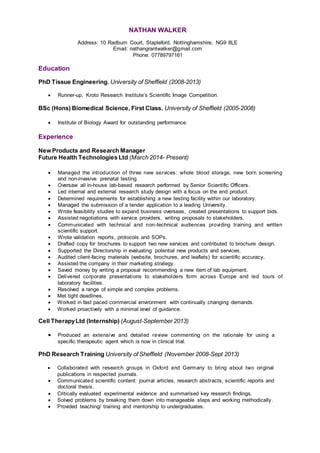
Nathan Walker's CV for Tissue Engineering Research Manager Role
- 1. NATHAN WALKER Address: 10 Radburn Court, Stapleford, Nottinghamshire, NG9 8LE Email: nathangrantwalker@gmail.com Phone: 07789797161 Education PhD Tissue Engineering. University of Sheffield (2008-2013) Runner-up, Kroto Research Institute’s Scientific Image Competition. BSc (Hons) Biomedical Science, First Class. University of Sheffield (2005-2008) Institute of Biology Award for outstanding performance. Experience New Products and Research Manager Future Health Technologies Ltd (March 2014- Present) Managed the introduction of three new services: whole blood storage, new born screening and non-invasive prenatal testing. Oversaw all in-house lab-based research performed by Senior Scientific Officers. Led internal and external research study design with a focus on the end product. Determined requirements for establishing a new testing facility within our laboratory. Managed the submission of a tender application to a leading University. Wrote feasibility studies to expand business overseas, created presentations to support bids. Assisted negotiations with service providers, writing proposals to stakeholders. Communicated with technical and non-technical audiences providing training and written scientific support. Wrote validation reports, protocols and SOPs. Drafted copy for brochures to support two new services and contributed to brochure design. Supported the Directorship in evaluating potential new products and services. Audited client-facing materials (website, brochures, and leaflets) for scientific accuracy. Assisted the company in their marketing strategy. Saved money by writing a proposal recommending a new item of lab equipment. Delivered corporate presentations to stakeholders form across Europe and led tours of laboratory facilities. Resolved a range of simple and complex problems. Met tight deadlines. Worked in fast paced commercial environment with continually changing demands. Worked proactively with a minimal level of guidance. Cell TherapyLtd (Internship) (August-September 2013) Produced an extensive and detailed review commenting on the rationale for using a specific therapeutic agent which is now in clinical trial. PhD Research Training University of Sheffield (November 2008-Sept 2013) Collaborated with research groups in Oxford and Germany to bring about two original publications in respected journals. Communicated scientific content: journal articles, research abstracts, scientific reports and doctoral thesis. Critically evaluated experimental evidence and summarised key research findings. Solved problems by breaking them down into manageable steps and working methodically. Provided teaching/ training and mentorship to undergraduates.
- 2. Appendix Research Abstract In healthy individuals, skin has a remarkable capacity for regeneration following damage, but age and diabetes-related vascular problems often lead to chronic non-healing wounds for many thousands of UK patients. Therefore, there is a need for new therapeutic approaches to treat these problematic wounds. In recent years, mesenchymal stem cells (MSCs) have been shown to assist cutaneous wound healing by accelerating re-epithelialisation and reducing scarring. My research aim was to investigate the role of MSCs in a wound environment using tissue-engineered skin (TE skin) as an in vitro 3D wound model. TE skin is skin that has been reconstructed from human dermis, fibroblasts and keratinocytes, such that it resembles ex-vivo skin. Firstly, a method for delivering MSCs to patients, that would be convenient and safe for a clinician to use, was derived. Plasma polymerisation was used to functionalise the surface of medical grade silicone with acrylic acid to make its surface favourable for MSC attachment. MSCs cultured on these 'carrier' surfaces retained their viability and phenotype, and could migrate to human dermis from the carrier’s surface with great efficiency upon contact with model wound beds. Once transferred, the MSCs remained viable. Secondly, a reproducible wound-healing model was developed from TE skin and the ability of MSCs to bring about wound healing in the model was investigated. MSCs were introduced to wounded TE skin, and Optical Coherence Tomography (OCT) was employed to non-invasively image the wound area over the course of healing. OCT is the light source equivalent of ultrasound, providing a much higher lateral and axial resolution than the latter. Samples containing MSCs did not heal faster than controls; however the rate of re-epithelialisation was improved. Restoration of the skin's barrier occurred several days earlier in the presence of MSCs, and this event could be detected by OCT. This observation was associated with increased levels of hepatocyte growth factor. Therefore, OCT proved an effective tool to investigate wound healing in vitro, and MSCs may have contributed to wound healing in a paracrine fashion. Publications Walker, N.G., Mistry, A.R., Smith, L.E., et al. “A chemically defined carrier for the delivery of human mesenchymal/stromal cells to model wound beds”.Tissue Engineering, 18,143-155,(2012). Jiang, D., Qi, Y., Walker, N.G., et al. “The effect of adipose tissue derived MSCs delivered by a chemicallydefined carrier on full-thickness cutaneous wound healing”.Biomaterials,34,2501-15,(2013). Walker, N.G., Beckett, S.J., Mittar, S., et al. “Optical coherence tomography real-time assessment of wound healing in a 3D tissue engineered skin model - the effects of adding mesenchymal stromal cells” British Journal Dermatology(Submitted November 2015). Oral Presentations ‘A chemically defined carrier for the delivery of MSCs’, Biomaterials and Tissue Engineering Group (BiTEG), 12th Annual Work in Progress Meeting (2010),University of York, UK. Poster Presentations ‘The uses of tissue engineered skin in translational research’, Tissue Engineering: The third dimension to animal replacement(2012),Royal College ofObstetricians and Gynaecologists,London,UK. ‘A chemically defined carrier for the delivery of human mesenchymal stem cell/stromal cells to skin wounds’,5th UK MSC Meeting (2011), Aston University, Birmingham,UK. ‘Evidence for nanotubes in human mesenchymal stem cells’, Quantitative Imaging for Systems Biology (2009),Oxford University, UK.